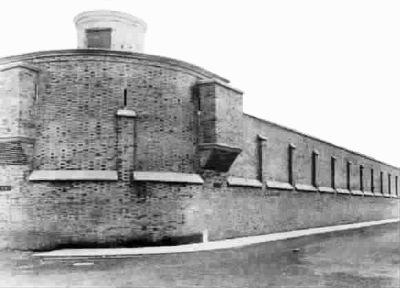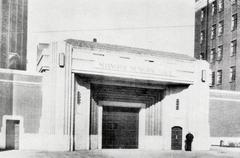
Tilanqiao Prison: Visiting Hours, Tickets, and Shanghai Historical Sites Guide
Date: 14/06/2025
Introduction
Tilanqiao Prison, historically known as Ward Road Gaol, is one of Shanghai’s most significant and evocative historical landmarks. Established between 1901 and 1903 during the era of the Shanghai International Settlement, the prison’s architecture and evolution mirror the city’s colonial legacy, wartime struggles, and ongoing modernization. Once the largest prison in East Asia, Tilanqiao’s imposing walls have housed common criminals, political dissidents, POWs, and notable historical figures. Today, with its transition from an active prison (closed July 2024) to a national cultural relic and museum, Tilanqiao provides visitors with a unique lens through which to explore Shanghai’s layered history.
Located in the Hongkou District, Tilanqiao Prison is easily accessible via public transportation and is surrounded by other key historical sites, such as the Shanghai Jewish Refugees Museum and Ohel Moishe Synagogue. As it becomes a center for “Red culture” and legal education, Tilanqiao continues to serve as a vital educational and commemorative resource, reflecting the city’s commitment to heritage preservation (Shanghai Museums Official Site; China Daily).
Table of Contents
- Overview and Historical Significance
- Architectural Highlights
- Visiting Tilanqiao Prison: Essential Information
- Nearby Attractions
- Recent Developments and Redevelopment Plans
- Frequently Asked Questions (FAQs)
- Plan Your Visit
- References and Further Reading
Overview and Historical Significance
Colonial Foundations and Early Growth (1901–1941)
Tilanqiao Prison was constructed at the turn of the 20th century to address the needs of the Shanghai International Settlement. Designed with influences from Western penal architecture, the prison was built for both Chinese and foreign inmates, with strict discipline and surveillance as core principles. By the 1930s, it covered over 70,000 square meters, featuring specialized blocks for juveniles, women, workshops, and a notable cross-shaped foreign prisoners’ building with a glass cupola.
Wartime and Political Upheaval (1941–1949)
During the Japanese occupation in World War II, the prison was used to detain Chinese dissidents, Western POWs, and European civilians. After the war, it served as a site for war crimes trials and political repression under both the Kuomintang and early Communist administrations.
Communist Era to Modern Day (1949–2024)
Renamed Shanghai People’s Prison, Tilanqiao became a maximum-security facility, detaining criminals and political prisoners. Notable inmates included Cao Diqiu, Zhang Aiping, Ren Bishi, and Chen Bijun (Global Times). While recognized as a model prison by authorities, it also received international criticism for human rights abuses. Its closure in 2024 marked a turning point, with plans for adaptive reuse as a museum and cultural site.
Architectural Highlights
Tilanqiao Prison’s design is a rare blend of Western penal principles and local adaptations:
- Cross-Shaped Building (1935): Originally for foreign inmates, it features a central glass-roofed atrium that maximizes light and enables efficient surveillance.
- Panopticon Surveillance: The prison employs panopticon-inspired layouts, with cell blocks radiating from observation points.
- Triple-Locking Gate System: Imported from the UK, this allowed for swift lockdowns and improved security.
- Women’s Block: A separate four-story building with a roof garden, providing a progressive approach to exercise and ventilation.
- Specialized Features: Rubber-walled isolation rooms, riot-control cells, and an execution chamber with a trapdoor.
These architectural elements not only ensured security but also contributed to the site’s distinctive historical identity (Metromod Archive).
Visiting Tilanqiao Prison: Essential Information
Opening Hours and Ticketing
- Hours: 9:00 AM – 5:00 PM, Tuesday through Sunday. Closed Mondays and major holidays.
- Ticketing: Admission is typically free or modestly priced (30–50 RMB for adults; discounts for students/seniors). Advance reservations are required due to limited daily capacity; book via the official Shanghai Museums website or authorized providers.
Guided Tours
- Guided tours are available in English and Mandarin, lasting approximately 60 minutes. Booking ahead is recommended for group or specialized tours.
Accessibility
- The museum areas are wheelchair accessible, with ramps and elevators in key locations. Some preserved sections may have limited access due to conservation needs.
Getting There
- Address: 147 Changyang Road, Hongkou District, Shanghai.
- Metro: Line 4 (Tilanqiao Station), Line 14 (North Bund Station; 10-minute walk).
- Bus: Multiple routes serve the area.
Visitor Guidelines
- Photography is allowed in designated areas only.
- Children under 12 must be accompanied by adults.
- Respectful conduct is required; follow all posted instructions.
Nearby Attractions
- Shanghai Jewish Refugees Museum: Documents the experiences of Jewish refugees in Shanghai during WWII.
- Ohel Moishe Synagogue: Former center of Jewish life in the district.
- North Bund Waterfront & Lu Xun Park: Scenic and cultural sites within walking distance.
These attractions complement a visit to Tilanqiao, offering a fuller understanding of Hongkou’s multicultural history (Lonely Planet).
Recent Developments and Redevelopment Plans
Recognized as a protected cultural relic since 1994 and upgraded to national status in 2013, Tilanqiao Prison’s closure as a correctional facility in July 2024 paves the way for transformation into a museum and cultural hub. The redevelopment plan preserves the main buildings and introduces legal education exhibits, community spaces, and commercial activities, modeled after successful conversions of heritage prisons worldwide (Global Times).
Frequently Asked Questions (FAQs)
Q: Is Tilanqiao Prison open to the public?
A: Yes, the museum section is open by reservation. The facility no longer functions as a prison.
Q: How do I book tickets?
A: Reserve online via the official Shanghai Museums website or through authorized travel agents.
Q: Are guided tours mandatory?
A: Not mandatory, but highly recommended for in-depth understanding.
Q: Is the site accessible to people with disabilities?
A: Yes, most exhibition areas are accessible; check in advance for specific needs.
Q: Can I take photographs?
A: Yes, but only in designated exhibition zones.
Plan Your Visit
Tilanqiao Prison offers a compelling journey through Shanghai’s complex past, blending architectural innovation with poignant human stories. For a richer experience, download the Audiala app for audio guides and interactive maps. Stay updated on special events and exhibitions by following official social media channels.
Experience history where it happened—reserve your Tilanqiao Prison visit today!
References and Further Reading
- Shanghai Museums Official Website
- China Daily’s coverage on Tilanqiao Prison
- Metromod Archive: Tilanqiao Prison Architectural Details
- Global Times: Tilanqiao Prison’s Role in Shanghai History
- Lonely Planet: Ward Road Jail
- Shanghai Tourism Board
Images and maps are available through official and authorized platforms. Internal links to related articles (Jewish Refugees Museum, North Bund) are suggested for further exploration.






















































































